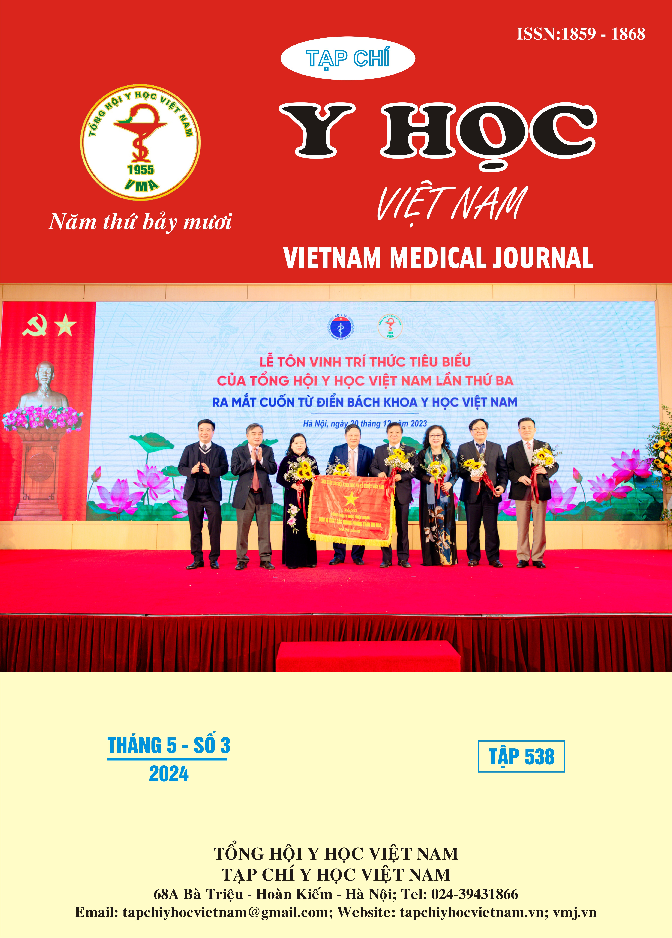REMOVAL OF A BENIGN PHYLLODE TUMOR BY ULTRASOUND-GUIDED VACUUM-ASSISTED BREAST EXCISION COMBINED WITH MONITORED ANESTHESIA CARE
Main Article Content
Abstract
Phyllode tumor (PT) is a rare fibrous epithelial tumor that accounts for less than 1% of breast tumors and is common in middle-aged women. Distinguishing phyllode tumors with fibroadenoma of the breast on clinical manifestations, imaging, and pathology is relatively difficult. The World Health Organization (WHO) divides phyllode tumors into three subtypes: benign, borderline, and malignant. Currently, the main method to remove PT is wide local excision >1 cm from the lesion margin to prevent local recurrence. However, benign phyllodes tumors (BPT) have a low local recurrence rate and there is disagreement about the treatment of these lesions. In this article, we present a clinical case of the removal of a benign phyllodes tumor larger than 6 cm in a 40-year-old Vietnamese woman by ultrasound-guided vacuum-assisted breast excision (VAE) combined with monitored anesthesia care (MAC). This method helps to optimize aesthetics for the patient as well as has a number of advantages over traditional surgical methods or vacuum-assisted breast excision under ultrasound guidance alone.
Article Details
Keywords
Benign phyllode tumor, breasts, surgery, vacuum-assisted breast excision, ultrasound.
References
2. Limaiem F, Kashyap S. Phyllodes Tumor Of The Breast. In: StatPearls. StatPearls Publishing; 2023. Accessed May 21, 2023. http://www.ncbi.nlm. nih.gov/books/NBK541138/
3. Qian Y, Quan ML, Ogilvi T, Bouchard-Fortier A. Surgical management of benign phyllodes tumours of the breast: Is wide local excision really necessary? Can J Surg. 2018;61(6):430-431. doi:10.1503/cjs.017617
4. Borhani-Khomani K, Talman MLM, Kroman N, Tvedskov TF. Risk of Local Recurrence of Benign and Borderline Phyllodes Tumors: A Danish Population-Based Retrospective Study. Ann Surg Oncol. 2016;23(5):1543-1548. doi:10. 1245/s10434-015-5041-y
5. Park HL, Pyo YC, Kim KY, et al. Recurrence Rates and Characteristics of Phyllodes Tumors Diagnosed by Ultrasound-guided Vacuum-assisted Breast Biopsy (VABB). Anticancer Res. 2018; 38(9):5481-5487. doi:10.21873/anticanres.12881
6. Ji Y, Zhong Y, Zheng Y, et al. Surgical management and prognosis of phyllodes tumors of the breast. Gland Surg. 2022;11(6):981-991. doi:10.21037/gs-21-877
7. Tse GMK, Niu Y, Shi HJ. Phyllodes tumor of the breast: an update. Breast Cancer. 2010;17(1):29-34. doi:10.1007/s12282-009-0114-z
8. Guillot E, Couturaud B, Reyal F, et al. Management of phyllodes breast tumors. Breast J. 2011; 17(2):129-137. doi: 10.1111/j.1524-4741. 2010.01045.x
9. Wiratkapun C, Piyapan P, Lertsithichai P, Larbcharoensub N. Fibroadenoma versus phyllodes tumor: distinguishing factors in patients diagnosed with fibroepithelial lesions after a core needle biopsy. Diagn Interv Radiol. 2014;20(1): 27-33. doi:10.5152/dir.2013.13133
10. Jacklin RK, Ridgway PF, Ziprin P, Healy V, Hadjiminas D, Darzi A. Optimising preoperative diagnosis in phyllodes tumour of the breast. Journal of Clinical Pathology. 2006;59(5):454-459. doi:10.1136/jcp.2005.025866


